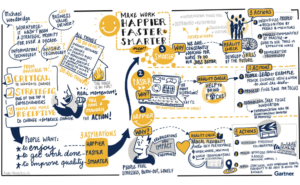Workers heading back to the office today have changed. They’ve had had time to think about what they want from their employers – and found some a disappointment when it comes to hybrid working.
Unhappy employees move somewhere happier, and workplace managers know that attrition of talent costs highly in recruitment and training.
As a workplace leader you need to navigate this new world and find solutions. And it’s not about tweaking this time – for the new workplace to succeed, it needs to see some changes at a profound cultural level.
What’s changed?
Workplace leaders are suddenly in charge of functioning hybrid workforces; home working and productivity proved surprisingly good partners during the lockdowns.
But organizations are still devising their strategies to tie home working into their organizational model, while employees are unsure how much they should be in the office anyway. And both sides need reassurance that it’s safe to bring people together once more.
There are long-term gains to be made, in productivity and worker wellbeing, and in cost and carbon savings – sudden digital transformation has already laid credible foundations for all of these ambitions. But in a world where one size definitely does not fit all, the challenge for workplace leaders is to sustain and build on the good start.
Changing the leadership culture to fit the hybrid workplace
In this new world, leaders wanting to create a new culture in their workplace need to fundamentally rethink their KPIs. Home working has demonstrated conclusively that being present is no longer the be-all and end-all of doing a good job.
Gartner is calling for more empathy in leadership. And around the world leaders are being asked to reconsider how they measure performance and encourage their people to do better.

The steps leaders need to take now:
Manage objectives – rather than old-style measuring employee attendance, leaders need to focus on what their staff are creating. Focus less on presenteeism and focus more on objectives and results.
Build trust – the hybrid working model will fail without it, for sure. Remote workers will resent the fact that their managers may not trust them and feel demotivated. Focus instead on the benefits for, say, introverted workers who may flourish at home.
Engage better – remote working does have its limitations, and with hybrid working becoming the norm, gaps in communication may occur. Leaders need to make sure communication is strengthened across the board, using all the channels available to engage with staff regardless of where they are.

Encourage feedback – typically, feedback has come from the top down. Encouraging feedback from the bottom up and from your peers will generate more ideas. Similarly, if you only give performance feedback to your team once a year then they are likely to be looking elsewhere for a job where less mind-reading is required. Make it continuous.
Rethink your location priorities – office work is now the perk, not WFH. Create the conditions where employees look forward to coming in to the office to collaborate and network with colleagues in safe, comfortable and enjoyable conditions.
Make asynchronous work the norm – this is work communication where people can respond in their own time, eg by online chat, email or online forums. It gives workers get the time and space to do their best work and carve out some work-life balance.
Save synchronous work for high impact – this is work communication that happens in real time, such as a meeting, and used to be the way work was done. It still has a place but should be saved for events where you need to make an impact. If your organization is at a pivotal moment or hard decisions need to be made, that’s the time to bring people together.
Supporting the new culture with technology
Hybrid working requires technological support if it is to flourish and turn your office into a productive, creative collaboration hub where wellness is a priority. Your agile workers need:
- Easy desk and room booking via an app so they can get on with their work when they arrive in the office, and be sure their space is clean and safe
- Colleague location facilities so they can co-ordinate collaboration activities
- Meeting scheduling technology to make it simple to organize meetings that combine virtual and in-person gatherings, even in multiple locations
- Contactless check-in and out of the office and workspaces via QR codes; staff and visitors can be prompted to confirm their health status before arrival
- Sensors to provide data showing how space is being utilized, so leaders can plan better.
Conclusion
There’s no roadmap for successful hybrid working – it’s happened too quickly for that, and best practice examples are still being discovered. Organizations around the world are feeling their way forward, learning what fits for them, and discarding elements that do not suit their operations.
The cultural experience of being at work has changed forever, and workplace leaders are working hard to accommodate the new demands of their employees and the evolved requirements. Adjustment is going to be continual – and in these shifting sands, technology will be the rock on which successful leaders can build a solid and sustainable future for their organizations and their workers.


